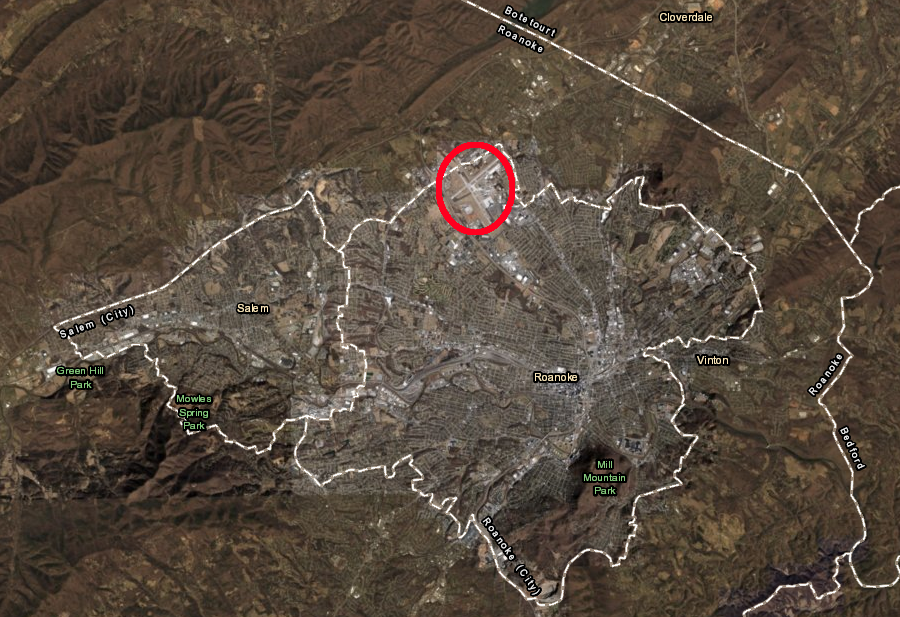
the Roanoke-Blacksburg Regional Airport (ROA) is a regional facility located within the City of Roanoke
Source: ESRI, ArcGIS Online

the Roanoke-Blacksburg Regional Airport (ROA) is a regional facility located within the City of Roanoke
Source: ESRI, ArcGIS Online
In 1929, the city of Roanoke leased land in Roanoke County for an airport. In 1934 the city purchased the Cannaday family farm and constructed the Roanoke Municipal Airport in the valley between Tinker Mountain to the west and the Blue Ridge to the east.
Scheduled commercial passenger service started that same year. The facility was expanded in World War II, and the field was named after Congressman Clifton Woodrum in appreciation of his support in obtaining Federal funding.
In the 1970's, Lynchburg and Roanoke considered a proposal to obtain funding from the Federal Aviation Administration and create a regional airport that would combine traffic from both communities. The proposed location in rural Bedford County drew local opposition, Roanoke citizens objected to closing the existing airport. Deregulation of the airline industry made the economics of a regional airport questionable. Roanoke ultimately chose to upgrade the existing Roanoke Municipal Airport.1
The potential for a joint airport serving both the Roanoke and Lynchburg markets has died. Local governments on opposite sides of the Blue Ridge have kept two competing, small airports that split the market, making it more difficult to get commercial airlines to increase service to either airport.
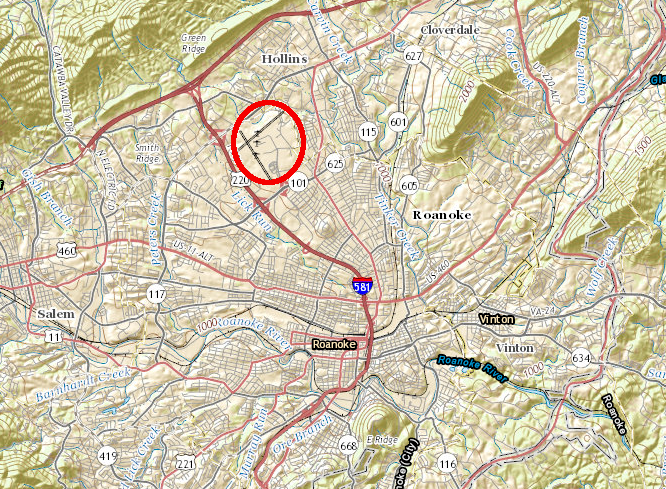
the Roanoke Regional Airport is located in the valley of the Roanoke River, bracketed by mountains to the east and west
Source: ESRI, ArcGIS Online
The city changed "Roanoke Municipal Airport/Woodrum Field" to "Roanoke Regional Airport/Woodrum Field" in 1983. It transferred the airport to a newly-created Roanoke Regional Airport Commission in 1987, which built a new terminal in 1989.
The City of Salem provided $1 million to start the Roanoke Regional Airport Commission in 1987, but declined to join Roanoke County and the City Roanoke as a governing member in that "regional" body. The city appointed three of the five members of the commission, and Roanoke County appointed the other two.
Issues of local identity, and competition between local governments, remained a significant barrier to inter-governmental cooperation for the next 30 years. In 2017, however, Salem reconsidered its stance. After two years of discussion, the city planned to become a voting member on the Roanoke Regional Airport Commission. The airport is located within the City of Roanoke, so the commission would be expanded and the city would get a fourth vote to ensure it retained a majority.2
In 2013, the Roanoke Regional Airport Commission decided to rename the airport and Blacksburg was added to the name starting in 2014. Calling the facility "Roanoke-Blacksburg Regional Airport" also acknowledged that 40% of the airport's traffic came from residents of the New River Valley.3
The airport has been called multiple names officially (the FAA identifier is "ROA"), but it has never moved from the original 1929 landing field near downtown Roanoke.
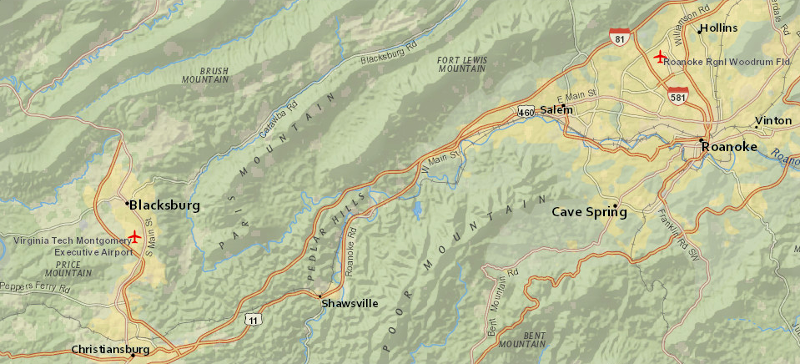
regional efforts to tighten economic and political links between Roanoke and Blacksburg are reflected in the 2013 decision to rename the Roanoke Regional Airport to the Roanoke-Blacksburg Regional Airport
Source: ESRI, ArcGIS Online
The 2013 name change was just the latest effort to expand the perception that the airport serviced the New River Valley region, in addition to the area close to the city of Roanoke. The addition of "Blacksburg" reflected increased political cooperation and economic integration of the Roanoke Valley with the New River Valley. Virginia Tech has spurred economic activity at the university's Corporate Research Center, and passenger traffic associated with the university helps keep the airport in Roanoke busy.
Modern cities require easy access to jet travel, and easy access to university expertise. Blacksburg offers the university; Roanoke offers the airport. There is a Virginia Tech Montgomery Executive Airport (formerly known as the VPI Airport) in Blacksburg. It is used by executive jets and private aircraft, but it does not offer scheduled commercial service.
One remaining issue is the distance between the university in Blacksburg and the airport in Roanoke, a roughly 30-minute drive up I-81 when traffic is not delayed by an accident. Urban sprawl in southwestern Virginia has not resulted in enough housing, retail, and commercial development to create one contiguous metropolitan area between Roanoke and Blacksburg. In contrast, Dulles International Airport is perceived as a Washington, DC airport due to the development (including Tysons) between the airport and downtown DC.
Proposals to upgrade the road connection between Virginia Tech and downtown Roanoke places has resulted in improvements to US 460 and I-81. However, efforts to create a more-direct route, extending the "Smart Road" to create a US 460 cut-off through Ellett Valley, have stalled. The environmental impacts, and the cost of constructing the extension through the valley and ridges in the area, are barriers to building a road that might invite the sprawl and create an expanded, unified metropolitan area.
Few airlines service the Roanoke-Blacksburg Regional Airport, due to the limited number of potential passengers. The commercial jets landing there are small, due in part to limited demand and in part due to the short runway surrounded by mountains. In 2014, a Delta jet was preparing to land on Runway 6/24 (6,800 feet long) when it discovered the runway was closed for maintenance. Company policy prevented landing the jet loaded with passengers on the shorter Runway 16/34 (5,810 feet long), and the plane was diverted to Greensboro, North Carolina.4
Airlines fly from Roanoke to a limited number of destinations, primarily Atlanta and Charlotte. In 2015 the airport offered 20-25 departures and an equal amount of arrivals daily, with four commercial airlines (Allegiant Air, Delta Air Lines, United Airlines, and American Airlines/US Airways and their regional airline affiliates) providing nonstop service to nine locations. No single airline dominated the market, in contrast to Lynchburg (serviced by only American).
There were no direct flights in 2015 from Roanoke to locations north of Philadelphia. The only direct flights to the west were to Columbus (Ohio) and Chicago. Delta Air Lines offered flights from Roanoke to Detroit between 1992-2014, but dropped that service because it was no longer profitable.5
Lynchburg Regional Airport, the nearest competing airport, offers much less service. In 2015, only US Airways offered passenger service at Lynchburg, and that airline flew only to Charlotte.
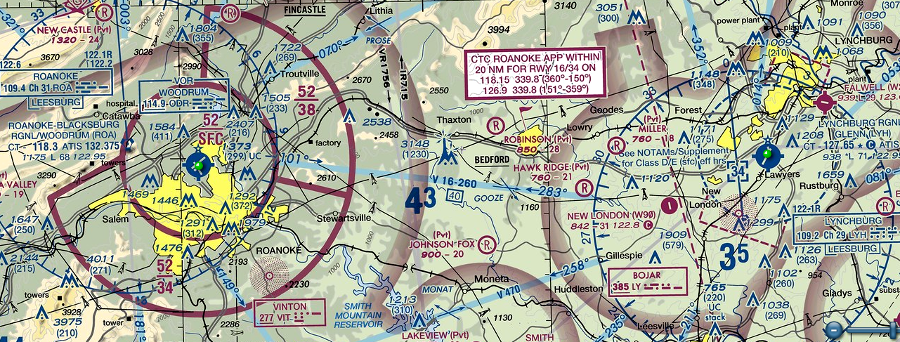
aeronautical chart for area including Roanoke-Blacksburg Regional Airport (ROA) and Lynchburg Regional Airport (LYH)
Source: SkyVector
Though Lynchburg is closer, a major competitor to Roanoke-Blacksburg Regional Airport is the Piedmont Triad International Airport (PTI) in Greensboro. That airport offers roughly twice the number of arrivals and departures daily with service north to New York City and as far west as Dallas-Fort Worth and Denver, in part because one of the three runways is 10,000 feet long. The Greensboro airport considers Roanoke, a two-hour drive away, to be within its "northern catchment area" for attracting customers.6
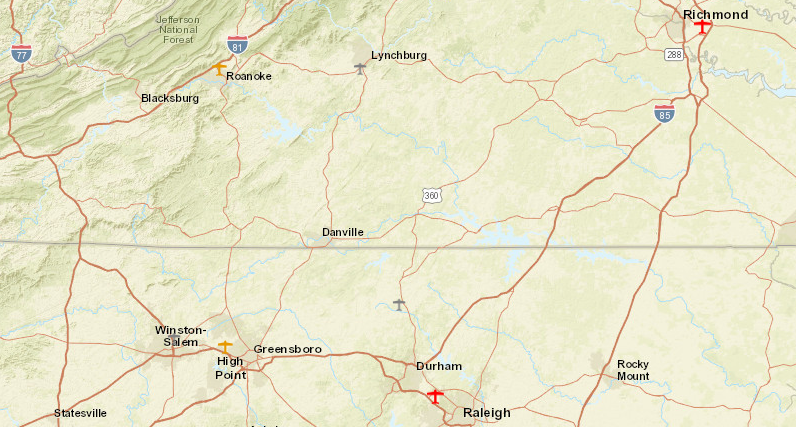
the Piedmont Triad International Airport in Greensboro, North Carolina is the primary competition for the Roanoke-Blacksburg Regional Airport
Source: ESRI, ArcGIS Online
A high percentage of the residents in the Roanoke area choose to fly from a different airport. In 2016, the 32% "leakage rate" was one of the highest in the United States. In 2017, another study estimated a 38% leakage rate, and that helped the airport get a $750,000 Small Community Air Service Development Program grant from the US Department of Transportation.
By 2019, however, the rate had skyrocketed to 66% of potential flyers in the main catchment zone. The 2019 study included data on how many people were taking advantage of the low-cost and ultra low-cost carriers flying from airports in Charlotte and Raleigh-Durham.
Roanoke officials would like to add those 90,000 trips taken by Roanoke residents at other airports to the 330,000 trips that arrive or leave from Roanoke-Blacksburg Regional Airport. In particular, leisure travelers in search of cheaper fares are willing to spend the time to drive from Roanoke to an airport in North Carolina or elsewhere in Virginia.
Increased demand might incentivize airlines to offer flights to new locations in the west (such as Denver and Dallas) and the north (particularly Boston). Adding additional flights to existing airports would also reduce leakage.
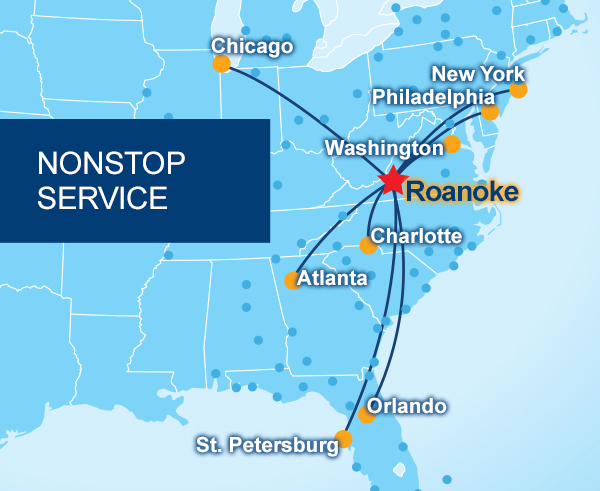
in 2019, the Roanoke-Blacksburg Regional Airport offered no non-stop flights to destinations west of the Mississipi River
Source: Roanoke-Blacksburg Regional Airport, Route Map
However, in 2016 service to Roanoke was reduced. United Express cut two of its three daily flights to Dulles, reallocating those aircraft to routes that generated higher profits. The Roanoke Times noted in an editorial that the airlines were phasing out the propeller-driven planes used at the Roanoke-Blacksburg Regional Airport and replacing them with short-range jets. The jets are more expensive to operate, and reductions in service reflect the constrained profit potential of servicing Roanoke.7
The limited ability to fly in and out of Roanoke affects the ability of Roanoke to retain its existing corporate offices. In 2014, Advance Auto Parts acquired a competitor, but instead of expanding in Roanoke it moved top executives and other employees to Raleigh, North Carolina. In 2015, Norfolk Southern railroad decided to close its Roanoke office and move 500 employees to Atlanta or Norfolk. One long-time Roanoke business executive responded to the economic development pattern, identifying a structural problem with Roanoke's future:8
The Roanoke Regional Airport Commission could issue bonds to expand the airport and attract new airlines, if a business plan showed that there would be enough new passengers at some time to generate sufficient revenue to repay those bonds.
If the business plan indicated that new revenue would not be sufficient, then local jurisdictions could fund expansion through tax dollars. Public subsidies for airport expansion could be justified as a matter of public policy, if local officials thought increased business activity associated with more airline service would stimulate the economy and increase local taxes to offset the subsidies.
The commission applied multiple times for a Small Commercial Air Service Development Program grant, awarded annually by the US Department of Transportation, to incentivize air carriers to increase service to communities with too few flights or too high fares. The 2015 application for a $600,000 grant also committed $200,000 from the airport and another $200,000 from local businesses, to create a $1 million pot of funding.
The offer of only a $200,000 match reflected the thin financial resources available to the airport commission, without additional direct funding by the city and county of Roanoke.
The Roanoke-Blacksburg Regional Airport was the last one in Virginia offering scheduled commercial passenger service to received a Small Commercial Air Service Development Program grant. In 2018, the US Department of Transportation awarded it a $750,000 grant to subsidize the costs of an existing carrier willing expanding service to a destination west of Chicago. Primary opportunities were starting service to Dallas via American Airlines, Denver via United Airlines, or Detroit via Delta Air Lines.9
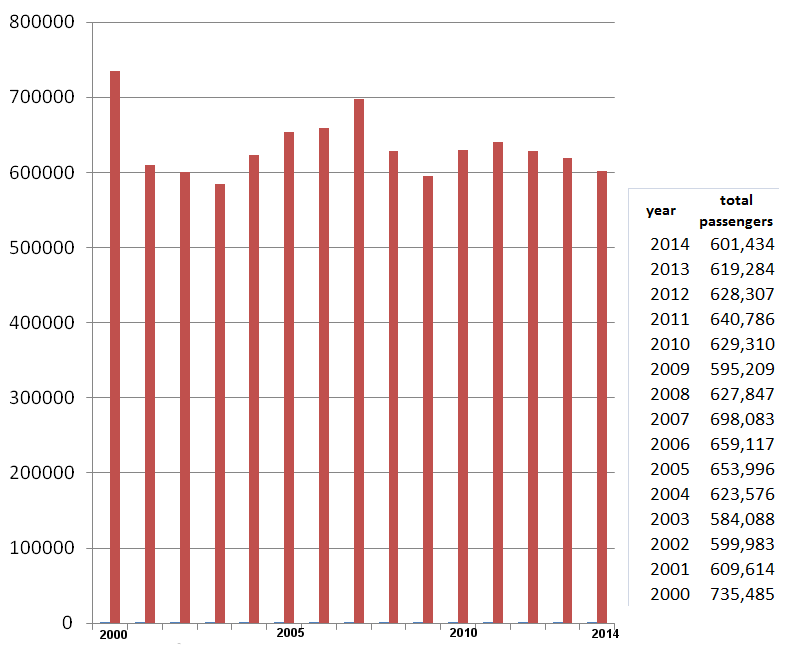
total passenger traffic at the Roanoke airport (arrivals + departures) averages between 600-700,000/year, and declined significantly after the economic recessions in 2000 and 2008
Source: Roanoke-Blacksburg Regional Airport, Monthly Statistical Report
Rather than to subsidize an airline to provide additional service, the cities of Salem and Roanoke chose to invest in an alternative economic development strategy to attract/retain business. In 2014 those two cities created the Roanoke Valley Broadband Authority.
For three years, the cities had discussed with Roanoke County and Botetourt County a proposal to subsidize installation of a fiber-optic line to provide faster telecommunications than what Comcast, Shentel, and other internet service providers were willing to provide. The local service providers offered Internet speeds of just 5-10 megabits per second, and local business and civic leaders feared companies would choose to create jobs in rival communities such as Chattanooga rather than in the Roanoke area.
The counties finally declined to invest in the project, but the cities chose to act without the desired county funding. Roanoke and Salem committed to build a network with a 10-gigabit backbone offering internet connections to local businesses with speeds of 50 megabits per second, and the potential of connections as fast as 1 gigabit per second.
Faster internet connections were seen as an investment in economic development that could attract or retain local businesses. The Roanoke Valley Broadband Authority issued a bond for $6.2 million, and two cities committed to a public subsidy to repay the debt until enough customers made the network self-supporting. The decision by Roanoke and Salem reflected a perception that it was a higher priority, and more cost-effective, to offer better internet connections than to expand airport service in the Roanoke region.10
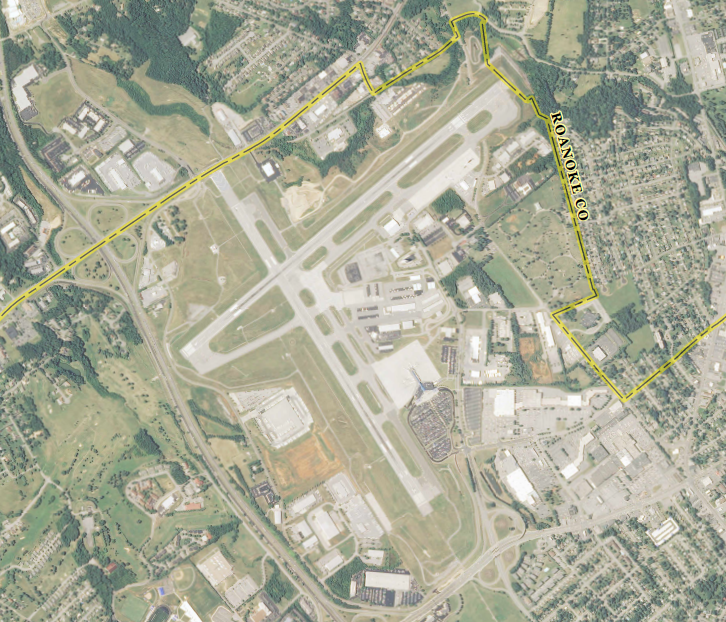
both Roanoke city and county officials serve on the Roanoke Regional Airport Commission, and the airport is located at the border of the two jurisdictions
Source: US Geological Survey (USGS), Roanoke 7.5x7.5 topographic map (2013)
The City of Roanoke also anticipated that passenger rail service from Amtrak would offer a realistic alternative to flying north to Washington DC. That passenger rail service began in 2017.
In 2019, the Executive Director expressed his frustrations with unrealistic public expectations of commercial airline service at the Roanoke-Blacksburg Regional Airport:11
The airport launched a marketing campaign in 2020 called Game Changer, before the COVID-19 pandemic altered travel patterns dramatically. It challenged local businesses to use the Roanoke-Blacksburg Regional Airport (ROA) whenever the cost of a ticket was within $300 of flight from a competing airport. The justification was that incidental costs from driving to Greensboro, Charlotte, Raleigh-Durham, or Dulles would approximate $300, including the value of the time lost in driving. In addition, increased traffic at the Roanoke airport would spur airlines to expand service and increase economic activity in the Roanoke area.12
The Roanoke-Blacksburg Regional Airport (ROA) also got into commercial land development by purchasing 17 acres of undeveloped land adjacent to the airport. It sought to build a new revenue source from land development, in addition to providing passenger travel services:13
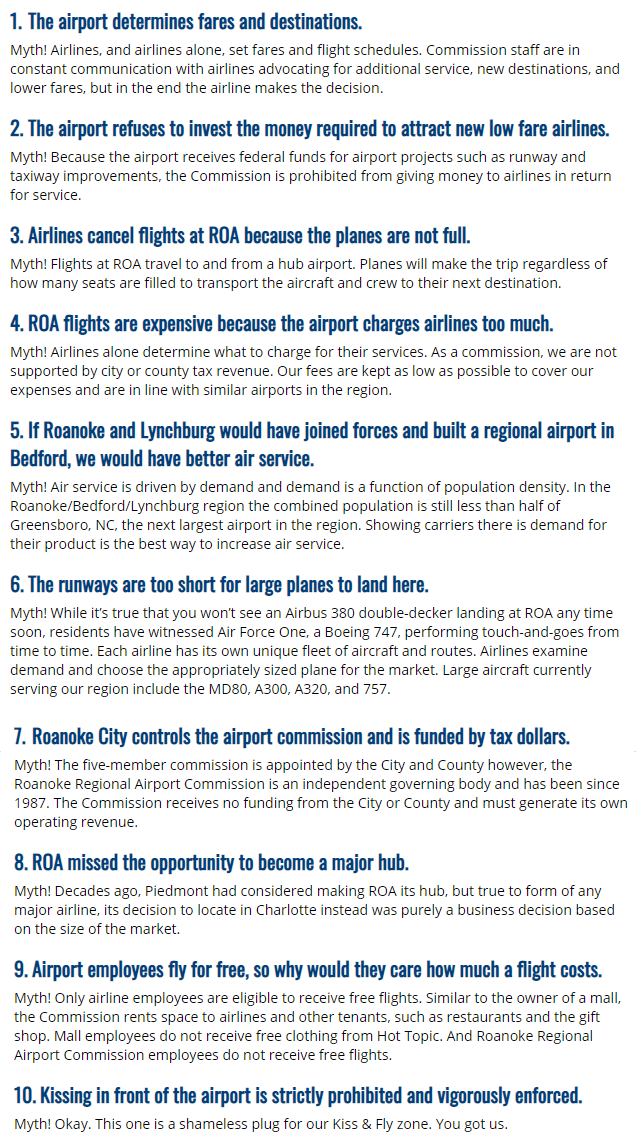
the airport has sought to dispel myths about cost and service on its website
Source: Roanoke-Blacksburg Regional Airport, ROA Myths
In 2025, a United Express flight with 50 passengers coming from Washington Dulles International Airport (IAD) landed in a heavy rainstorm on the secondary runway. The plane overran the end of the 5,800-foot runway.
The paved extension beyond that point was made from crushable concrete blocks. As designed, they collapsed under the weight of the jet and stopped the plane safely; there were no injuries. The Engineered Materials Arresting System had been upgraded just a year earlier.14
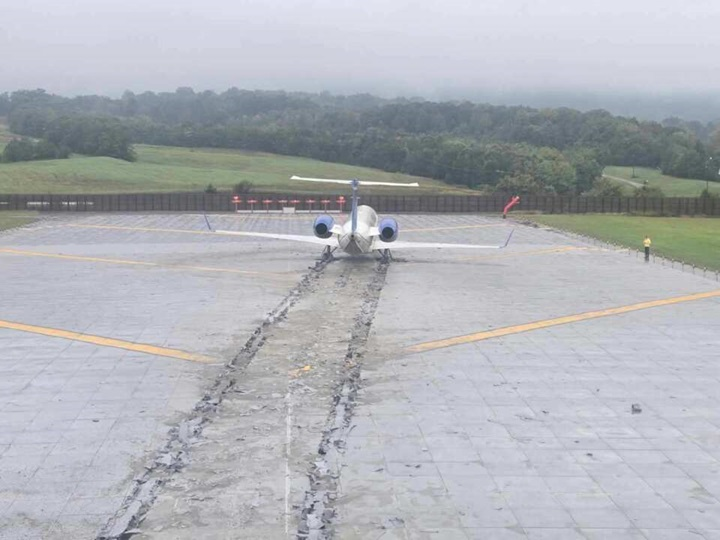
the Engineered Materials Arresting System successfully stopped a runway excursion in 2025
Source: WDBJ7, Facebook post (September 25, 2025)
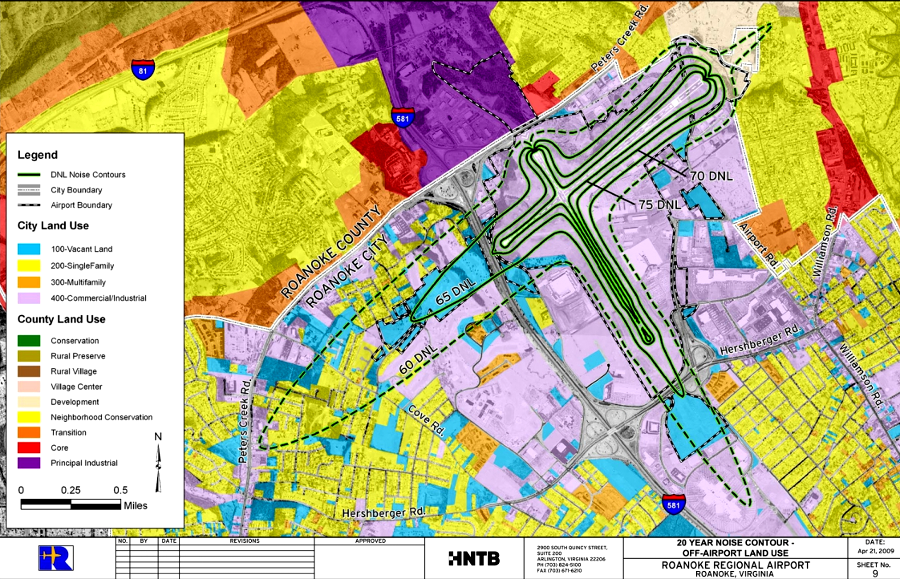
the property underneath the flight path at Roanoke-Blacksburg Regional Airport is zoned for commercial and industrial use, minimizing the number of residents who might compain about noise
Source: US Bureau of Census, Noise Exposure Map - 2025
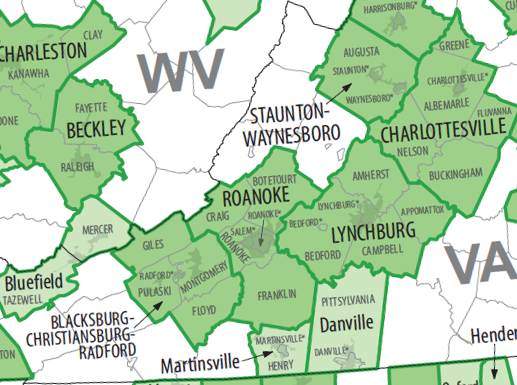
the 2013 classifications by the Census Bureau of Micropolitan Statistical Areas separated the Roanoke River Valley and New River Valley
Source: US Bureau of Census, Metropolitan and Micropolitan Statistical Areas (CBSAs) of the United States and Puerto Rico (February 2013)